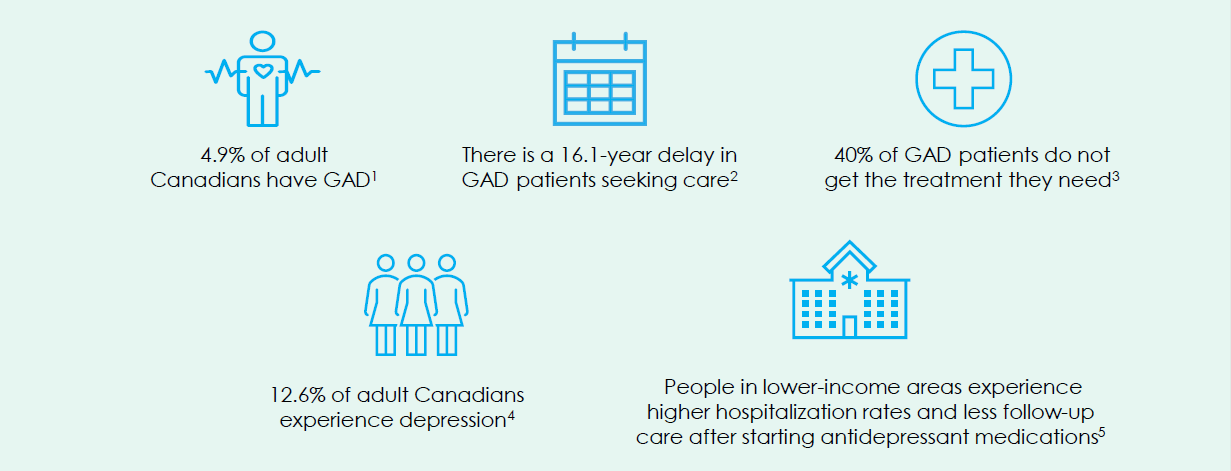A case study on clinician experience with the Anxiety and Depression EMR Tool in primary care
The Evidence2Practice Ontario (E2P) Anxiety Disorders and Depression (A&D) EMR Tool supports clinicians in providing the optimal standard of care for adults with anxiety and depression by giving them access to the most up-to-date evidence at the point of care.
Key takeaway
E2P’s EMR-integrated point-of-care tools provide clinicians with access to the right evidence at the right time, allowing them to focus on caring for their patients while ensuring alignment with clinical best practices. Grounded in Ontario Health’s quality standards, the E2P A&D tool supports the screening and assessment of patients with risk factors for A&D and the use of a stepped approach to care and supports patient self-management with local and virtual resources.
Generalized anxiety disorder (GAD) and major depression (MD) are among the most common mental health disorders in Canada.

This case study explores how the E2P A&D tool supports evidence-based care by examining real-world use by a clinician in a comprehensive family medicine practice. These findings emphasize the benefits of structured assessments in family practice and provide insights for clinicians looking to integrate digital tools to improve workflow efficiency, patient care, and better align their care approach with best practices.
Impact in practice
Dr. Altaweel is an experienced family physician working in a comprehensive primary care practice in Brampton, Ontario. With a patient panel of ~1,700 individuals, his clinic serves a diverse community spanning various ages, ethnicities and social backgrounds. His clinic began using the E2P A&D tool in May 2023. We recently sat down with Dr. Altaweel and he shared his experiences using the tool, and how it helps him apply best evidence and practice into his day-to-day patient care:
Workflow and ease of use
Dr. Altaweel discussed how the tool helps him manage patient care, particularly the medication management module and medication reference table. He found the tool helpful for tracking patient medication history, including dosage adjustments and drug interactions, as the tool features information related to medication issues. The tool also saves Dr. Altaweel time by generating encounter notes directly, reducing the need for additional documentation outside the consultation.
Improved patient care
Improving patient care is a key focus in Dr. Altaweel’s practice. Dr. Altaweel emphasizes that the tool helps him manage patients safely in the community before considering referral to further psychiatric care. This personalized, flexible approach ensures that patients receive the most appropriate level of care based on their individual needs. His care reflects the stepped care approach, a model that ensures patients receive the least intensive, yet effective, intervention first, escalating care only when necessary. This minimizes unnecessary psychiatric referrals while ensuring that urgent cases (e.g., suicidal patients) receive immediate, specialized intervention.
Application of Quality Standards
Dr. Altaweel’s approach to mental health care was supported by the E2P tool through early identification, timely follow-up,
continuous monitoring, and safe medication management. He
shared how the GAD 7 and PHQ 9 standardized assessment tools were useful for translating subjective symptoms into objective data and making it easier to engage patients in a discussion about their mental health. He did, however, note gaps in documentation and follow-up during patient transitions across services, which can disrupt care continuity. Improved communication between providers could enhance patient outcomes.
It gives us an idea that, first of all, we are not missing something. Secondly, how we are going to make a plan for the patient, so the patient is aware of what’s going on for the next step… I think it helps standardize the care for every patient.
Dr. Z. Altaweel
Physician, Brampton, ON
Works Cited
- World Health Organization. “Depression and Other Common Mental Disorders.” 2017 [Online]. Available at: https://www.who.int/publications-detail-redirect/depression-globalhealth-
estimates. - Johnson EM, Coles ME. Failure and delay in treatment-seeking across anxiety disorders. Community Ment Health J. 2013 Dec;49(6):668–74. doi:
10.1007/s10597-012-9543-9. - Katzman MA, Bleau P, Blier P, Chokka P, Kjernisted K, Van Ameringen M, et al. Canadian clinical practice guidelines for the management of anxiety, posttraumatic stress and
obsessive-compulsive disorders. BMC Psychiatry. 2014 Jul 2;14(1):S1. doi: 10.1186/1471-244X-14-S1-S1. - Pearson C, Janz T, Ali J. Health at a Glance: Mental and substance use disorders in Canada [Internet]. Statistics Canada; 2013. Available from:
https://www150.statcan.gc.ca/n1/pub/82-624-x/2013001/article/11855-eng.pdf - Knudsen SV, Valentin JB, Videbech P, Mainz J, Johnsen SP. Inequities in mental health care quality and clinical outcomes among inpatients with depression within a tax-financed
universal health care system. Clin Epidemiol. 2022;14:803–813. doi: 10.2147/CLEP.S322392.
This document is not to be reprinted without permission from the Evidence2Practice Ontario program.

Evidence2Practice Ontario (E2P) brings together multi-disciplinary, cross-sector expertise under the joint leadership of the Centre for Effective Practice, Amplify Care, and North York General Hospital. Funding and strategic guidance for E2P is provided by Ontario Health in support of Ontario’s Digital First for Health Strategy.

Interested in learning more?
Interested in partnering with us or learning more about
what we can offer you? Please reach out here.
Get the latest resources and insights
-

eReferral annual user satisfaction survey September 2022 – increase in usage
The Ontario eServices Program deploys a User Satisfaction Survey once a year in order to gather…
-

Amplify Care at AFHTO 2025: Driving Digital Adoption and Innovation in Primary Care
Members of the Amplify Care team were thrilled to participate in the Association of Family…
-

eReferral and patient communication in care transitions
Patient-centred care (PCC) is a priority for the Ontario Ministry of Health (MOH).1 Communication between…
-

Patients are highly satisfied with eReferral for diagnostic imaging
Based on Diagnostic Imaging eReferrals sent in seven sub-regions (WW, ESC, SE, NE, Champlain, SW…